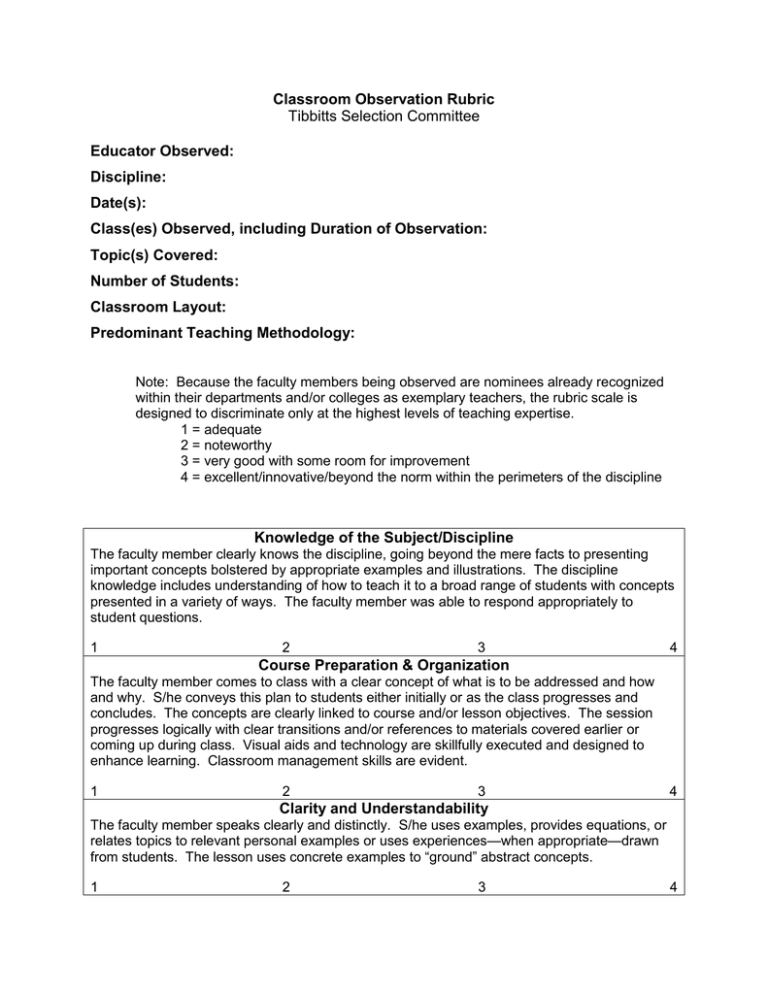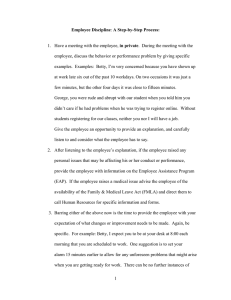Classroom Observation Evaluation
advertisement

Classroom Observation Rubric Tibbitts Selection Committee Educator Observed: Discipline: Date(s): Class(es) Observed, including Duration of Observation: Topic(s) Covered: Number of Students: Classroom Layout: Predominant Teaching Methodology: Note: Because the faculty members being observed are nominees already recognized within their departments and/or colleges as exemplary teachers, the rubric scale is designed to discriminate only at the highest levels of teaching expertise. 1 = adequate 2 = noteworthy 3 = very good with some room for improvement 4 = excellent/innovative/beyond the norm within the perimeters of the discipline Knowledge of the Subject/Discipline The faculty member clearly knows the discipline, going beyond the mere facts to presenting important concepts bolstered by appropriate examples and illustrations. The discipline knowledge includes understanding of how to teach it to a broad range of students with concepts presented in a variety of ways. The faculty member was able to respond appropriately to student questions. 1 2 3 4 Course Preparation & Organization The faculty member comes to class with a clear concept of what is to be addressed and how and why. S/he conveys this plan to students either initially or as the class progresses and concludes. The concepts are clearly linked to course and/or lesson objectives. The session progresses logically with clear transitions and/or references to materials covered earlier or coming up during class. Visual aids and technology are skillfully executed and designed to enhance learning. Classroom management skills are evident. 1 2 3 4 Clarity and Understandability The faculty member speaks clearly and distinctly. S/he uses examples, provides equations, or relates topics to relevant personal examples or uses experiences—when appropriate—drawn from students. The lesson uses concrete examples to “ground” abstract concepts. 1 2 3 4 Enthusiasm for Subject/Teaching The faculty member clearly cares passionately about the subject matter, the students’ learning, and teaching itself. This enthusiasm can be manifested by comments such as, “This is really cool,” or “You will LOVE this experiment/example,” and/or by the teacher’s animation. The faculty member clearly wants to be present and is glad to have the students present and engaged. 1 2 3 4 Sensitivity to and Concern with Students’ Level and Learning Process The faculty member knows and uses students’ names, interacting with a respect for student identities and learning. Faculty member “reads” students’ comprehension as the lesson progresses with appropriate pacing. S/he listens carefully to student comments, asking probing questions, paraphrasing, and referring to previous contributions. 1 2 3 4 Student Engagement with the Learning [Note: Engagement in a small seminar class will obviously look different than engagement in a large lecture class with students seated in an auditorium. The discipline, class size, course, level, and UNR student culture can influence these criteria.] Given these different challenges, how well did the faculty member involve students in the lesson and motivate them to prepare? How did the teacher challenge them, particularly to exhibit critical thinking skills, if appropriate? How did the teacher initiate student-to-student exchanges? How did the teacher keep students focused on the material being covered? 1 2 Overall Comments/Summary: 3 4




